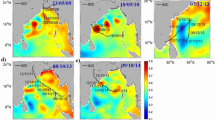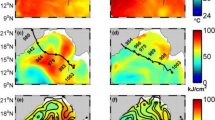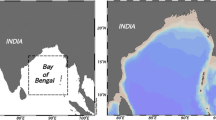Abstract
Oceanic eddies span over a wide range of sizes and affect the thermodynamic properties of water column. By modifying the thermal structure of the upper ocean, these eddies influence the air-sea heat exchange and, therefore, the strength of a tropical cyclone (TC) that passes over the eddy zone. To understand the interaction of tropical cyclone with different types of eddies (cyclonic and anticyclonic) over the Bay of Bengal (BoB) region, three idealized numerical experiments are performed using an atmosphere–ocean–wave coupled model. In these experiments, the atmospheric and wave models are forced by the realistic surface forcing (i.e. wind, pressure, heat and momentum fluxes) of the Vardah cyclone period (10–15 December 2016) in the BoB. The ocean model is initialized with three idealized conditions, i.e. horizontally constant profile of temperature and salinity throughout the model domain, idealized three-dimensional (3-D) temperature and salinity profiles in the area of 2° radius for cyclonic eddy and anticyclonic eddy. The 3-D eddy profile is placed in the path of TC Vardah track. The strength and radius of both idealized cyclonic and anticyclonic eddies are kept same. The model-simulated results of these three experiments were intercompared and it is found that the tropical cyclone interaction with an anticyclonic eddy had provided an ancillary strength to the TC by raising the tropical cyclone heat potential (TCHP) in comparison with other experiments. The utilization of coupled ocean–atmosphere–wave model had also provided a better representation of ocean–atmosphere coupled feedback processes during TC interaction with different eddies. The analysis of feedback processes depicted that the TC interaction with an anticyclonic eddy has raised the magnitude of its existing moist-static-energy comparative to the cyclonic eddy interaction case which resulted into an increase in the strength of the TC.














Similar content being viewed by others
References
Ali MM, Jagadeesh PSV, Jain S (2007) Effects of eddies on Bay of Bengal cyclone intensity. Eos Trans Am Geophys Union 88:93–95. https://doi.org/10.1029/2007EO080001
Babin SM, Carton JA, Dickey TD, Wiggert JD (2004) Satellite evidence of hurricane-induced phytoplankton blooms in an oceanic desert. J Geophys Res 109:C03043. https://doi.org/10.1029/2003JC001938
Balaguru K, Ping C, Saravanan R, Ruby LL, Zhao X, Mingkui L, Hsieh JS (2012) Ocean barrier layers’ effect on tropical cyclone intensification. Proc Natl Acad Sci 109(36):14343–14347. https://doi.org/10.1073/pnas.1201364109
Bao JW, Wilczak JM, Choi JK, Kantha H (2000) Numerical simulations of air–sea interaction under high wind conditions using a coupled model: a study of hurricane development. Mon Wea Rev 128:2190–2210. https://doi.org/10.1175/1520-0493(2000)128,2190:NSOASI.2.0.CO;2
Carton JA, Chepurin GA, Chen L (2018) SODA3: a new ocean climate reanalysis. J Climate 31:6967–6983. https://doi.org/10.1175/JCLI-D-18-0149.1
Chatterjee A, Shankar D, McCreary JP, Vinayachandran PN, Mukherjee A (2017) Dynamics of Andaman Sea circulation and its role in connecting the equatorial Indian Ocean to the Bay of Bengal. J Geophys Res Oceans 122:3200–3218. https://doi.org/10.1002/2016JC012300
Chang SW, Anthes FA (1979) The mutual response of the tropical cyclone and the ocean. J Phys Oceanogr 9:128–135
Cheng X, Xie SP, McCreary JP, Qi Y, Du Y (2013) Intraseasonal variability of sea surface height over the Bay of Bengal. J Geophys Res Oceans 118:816–830. https://doi.org/10.1002/jgrc.20075
Cheng X, McCreary JP, Qiu B, Qi Y, Du Y (2017) Intraseasonal-to-semiannual variability of sea-surface height in the eastern, equatorial Indian Ocean and southern Bay of Bengal. J Geophys Res Oceans 122:4051–4067. https://doi.org/10.1002/2016JC012662
Chen S, Chen D, Xing J (2017) A study on some basic features of inertial oscillations and near-inertial internal waves. Ocean Sci 13:829–836. https://doi.org/10.5194/os-13-829-2017
Chen G, Li Y, Xie Q, Wang D (2018) Origins of eddy kinetic energy in the Bay of Bengal. J Geophys Res Oceans 123:2097–2115. https://doi.org/10.1002/2017JC013455
Chen G, Wang D, Hou Y (2012) The features and interannual variability mechanism of mesoscale eddies in the Bay of Bengal. Cont Shelf Res 47:178–185
Chen S, Campbell TJ, Jin H, Gabersek S, Hodur RM, Martin P (2010) Effect of two-way air–sea coupling in high and low wind speed regimes. Mon Wea Rev 138:3579–3602.
Cione JJ, Uhlhorn EW (2003) Sea surface temperature variability in hurricanes: implications with respect to intensity change. Mon Weather Rev 131:1783–1796
D’Asaro E, Black P, Centurioni L, Harr P, Jayne S, Lin I-I, Lee C, Morzel J, Mrvaljevic R, Niiler P, Rainville L, Sanford T, David Tang T-Y (2011) Typhoon-ocean interaction in the western North Pacific, part 1. Oceanography 24(4):24–31. https://doi.org/10.5670/oceanog.2011.91
Drennan WM, Graber HC, Hauser D, Quentin C (2003) On the wave age dependence of wind stress over pure wind seas. J Geophys Res 108:8062. https://doi.org/10.1029/2000JC000715
Drennan WM, Taylor PK, Yelland MJ (2005) Parameterizing the sea surface roughness. J Phys Oceanogr 35:835–848
Du J, Larsen XG, Bolanos R (2015) A coupled atmospheric and wave modeling system for storm simulations. In: Proceedings of EWEA Offshore 2015 conference European Wind Energy Association (EWEA)
Dutta D, Mani B (2019) Dash MK (2020) Dynamic and thermodynamic upper-ocean response to the passage of Bay of Bengal cyclones “Phailin” and “Hudhud”: a study using a coupled modelling system. Environ Monit Assess 191:808. https://doi.org/10.1007/s10661-019-7704-9
Emanuel KA (2003) Tropical cyclones. Annu Rev Earth Planet Sci 31:75–104
Emanuel KA, DesAutels C, Holloway C, Korty R (2004) Environmental control of tropical cyclone intensity. J Atmos Sci 61:843–858. https://doi.org/10.1175/1520-0469(2004)061,0843:ECOTCI.2.0.CO;2
Emanuel KA (1999) Thermodynamic control of hurricane intensity. Nature 401(665–669):10
Gopalan AKS, Gopalakrishna VV, Ali MM, Sharma R (2000) Detection of Bay of Bengal eddies from TOPEX and in situ observations. J Mar Res 58:721–734
Gordon AL, Shroyer E, Murty VSN (2017) An intrathermocline eddy and a tropical cyclone in the Bay of Bengal. Sci Rep 7:46218. https://doi.org/10.1038/srep46218
Gray WM (1979) Hurricanes: their formation structure and likely role in the tropical circulation. In: Shaw DB (ed) Meteorology over the Tropical Oceans. Reading, London, pp 155–218
Gray WM (1975) Tropical cyclone genesis. Atmos Sci Paper No. 234, Colo. State Univ., Ft Collins CO, p 121
Jaimes B, Shay LK (2009) Mixed layer cooling in mesoscale oceanic eddies during Hurricanes Katrina and Rita. Mon Wea Rev 137:4188–4207. https://doi.org/10.1175/2009MWR2849.1
Jaimes B, Shay LK, Brewster JK (2016) Observed air-sea interactions in tropical cyclone Isaac over Loop Current mesoscale eddy features. Dyn Atmos Oceans 76:306–324. https://doi.org/10.1016/j.dynatmoce.2016.03.001
Ji J, Dong C, Zhang B, Liu Y, Zou B, King GP et al (2018) Oceanic eddy characteristics and generation mechanisms in the Kuroshio Extension region. J Geophys Res Oceans. https://doi.org/10.1029/2018JC01419675/2009MWR3119.1
Kain J, Fritsch M (1993) Convective parameterization for mesoscale models: the Kain-Fritsch scheme. The representation of cumulus convection in numerical models. Meteor Mono Am Meteor Soc 24:165–170
Larson J, Jacob R, Ong E (2005) The model coupling Toolkit: a new Fortran90 toolkit for building multiphysics parallel coupled models. Int J High Perform Comput Appl 19(3):277–292
Lin YL, Rarley RD, Orville HD (1983) Bulk parameterization of the snow field in a cloud model. J Appl Meteor 22:1065–1092
Lin II, Wu CC, Emanuel K, Lee IH, Wu CR, Pun IF (2005) The interaction of Super typhoon Maemi (2003) with a warm ocean eddy. Mon Weather Rev 133(9):2635–2649
Lin II, Wu CC, Pun IF, Ko DS (2008) Upper-ocean thermal structure and the western North Pacific category 5 typhoons Part I: ocean features and the category 5 typhoons’ intensification. Mon Weather Rev 136(9):3288–3306
Lin II, Goni GJ, Knaff JA, Cristina F, Ali KM (2013) Ocean heat content for tropical cyclone intensity forecasting and its impact on storm surge. Nat Hazards 66:1481. https://doi.org/10.1007/s11069-012-0214-5
Lloyd ID, Vecchi GA (2011) Observational evidence for oceanic controls on hurricane intensity. J Climate 24:1138–1153. https://doi.org/10.1175/2010JCLI3763.1
Longshore D (2008) Encyclopedia of hurricanes, typhoons, and cyclones. Checkmark, New York, p 468
Ma X, Chang P, Saravanan R, Montuoro R, Hsieh JS, Wu D, Lin X, Wu L, Jing Z (2015) Distant influence of Kuroshio eddies on North Pacific weather patterns. Sci Rep 5:17785. https://doi.org/10.1038/srep17785
Ma Z, Fei J, Liu L, Huang X, Cheng X (2013) Effects of the cold core eddy on tropical cyclone intensity and structure under idealized air–sea interaction conditions. Mon Wea Rev 141:1285–1303. https://doi.org/10.1175/MWR-D-12-00123.1
Mao J, Wu G (2011) Barotropic process contributing to the formation and growth of tropical cyclone Nargis. Adv Atmos Sci 28:483. https://doi.org/10.1007/s00376-010-9190-4
Maneesha K, Sadhuram Y, Prasad KVSR (2015) Role of upper ocean parameters in the genesis, intensification and tracks of cyclones over the Bay of Bengal. J Oper Oceanogr 8(2):133–146. https://doi.org/10.1080/1755876X.2015.1087185
McPhaden MJ, Foltz GR, Lee T, Murty VSN, Ravichandran M, Vecchi GA, Vialard J, Wiggert JD, Yu L (2009) Ocean-atmosphere interactions during cyclone Nargis. Eos Trans AGU 90:53–60
Mawren D, Reason CJC (2017) Variability of upper-ocean characteristics and tropical cyclones in the South West Indian Ocean. J Geophys Res Oceans. https://doi.org/10.1002/2016JC012028
Mowla KG (1968) Cyclogenesis in the Bay of Bengal and Arabian Sea. Tellus 20(1):151–162.
Nakanishi M (2001) Improvement of Mellor-Yamada turbulence closure model based on large-eddy simulation data. Bound-Layer Meteor 99:349–378
Nakanishi M, Niino H (2004) An improved Mellor-Yamada level-3 model with condensation physics: its design and verification. Bound-Layer Meteor 112:1–31
Nakanishi M, Niino H (2006) An improved Mellor-Yamada level-3 model: its numerical stability and application to a regional prediction of advection fog. Bound-Layer Meteor 119:397–407
Nakanishi M, Niino H (2009) Development of an improved turbulence closure model for the atmospheric boundary layer. J Meteor Soc Japan 87:895–912
National geophysical data center: 2-minute gridded global relief data (ETOPO2) v2. National Geophysical Data Center, NOAA (2006), available at: https://doi.org/https://doi.org/10.7289/V5J1012Q. Accessed July 2015.
Neetu S, Lengaigne M, Vincent EM, Vialard J, Madec J, Samson G, Ramesh Kumar MR, Durand F (2012) Influence of upper-ocean stratification on tropical cyclone-induced surface cooling in the Bay of Bengal. J Geophys Res 117:C12020. https://doi.org/10.1029/2012JC008433.402/tellusa.v20i1.9995
Nigam T, Prakash KR, Pant V (2019) An assessment of the impact of oceanic initial conditions on the interaction of upper ocean with the tropical cyclones in the Arabian Sea. J Oper Oceanogr. https://doi.org/10.1080/1755876X.2019.165867
Olabarrieta M, Warner JC, Armstrong B, Zambon JB, He R (2012) Ocean atmosphere dynamics during Hurricane Ida and Nor’Ida: an application of the coupled ocean atmosphere wave sediment transport (COAWST) modeling system. Ocean Model 43:112–137
Patnaik KVKRK, Maneesha K, Sadhuram Y, Prasad KVSR, Ramana Murty TV, Brahmananda Rao V (2014) East India Coastal Current induced eddies and their interaction with tropical storms over Bay of Bengal. J Oper Oceanogr 7(1):58–68. https://doi.org/10.1080/1755876X.2014.11020153
Prakash KR, Pant V (2017) Upper oceanic response to tropical cyclone Phailin in the Bay of Bengal using a coupled atmosphere-ocean model. Ocean Dynam 67:51–64. https://doi.org/10.1007/s10236-016-1020-5
Prakash KR, Nigam T, Pant V (2018) Estimation of oceanic subsurface mixing under a severe cyclonic storm using a coupled atmosphere–ocean–wave model. Ocean Sci 14:259–272. https://doi.org/10.5194/os-14-259-2018
Prakash KR, Pant V, Nigam T (2019) Effects of the sea surface roughness and sea spray-induced flux parameterization on the simulations of a tropical cyclone. J Geophys Res Atmos 124:14037–14058. https://doi.org/10.1029/2018JD029760
Price JF (1981) Upper ocean response to a hurricane. J Phys Oceanogr 11:153–175
Price JF, Sanford TB, Forristall GZ (1994) Forced stage response to a moving hurricane. J Phys Oceanogr 24:233–260
Pun IF, Chang YT, Lin II, Tang TY, Lien RC (2011) Typhoon-ocean interaction in the Western North Pacific, Part 2. Oceanography 24(4):32–41. https://doi.org/10.5670/oceanog.2011.92
Rayson MD, Ivey GN, Jones NL, Lowe R, Wake GW, McConochie JD (2015) Near-inertial ocean response to tropical cyclone forcing on the Australian North-West Shelf. J Geophys Res Oceans 120:7722–7751. https://doi.org/10.1002/2015JC010868
Sadhuram Y, Rao BP, Rao DP, Shastri PNM, Subrahmanyam MV (2004) Seasonal variability of cyclone heat potential in the Bay of Bengal. Nat Hazards 32:191–209. https://doi.org/10.1023/B:NHAZ.0000031313.43492.a8
Sanford TB, Black PG, Haustein JR, Feeney JW, Forristall GZ, Price JF (1987) Ocean response to a hurricane, Part I: observations. J Phys Oceanogr 17:2065–2083
Shay LK, Goni GJ, Black PG (2000) Effects of a warm oceanic feature on hurricane opal. Mon Wea Rev 128(1366–1383):12
Shen W, Ginis I (2003) Effects of surface heat flux-induced sea surface temperature changes on tropical cyclone intensity. Geophys Res Lett 30:1933–1936
Shchepetkin AF, McWilliams JC (2005) The regional oceanic modeling system (roms)-a split-explicit, free-surface, topography-following-coordinate oceanic model. Ocean Model 9(4):347–404
Skamarock WC, Klemp J, Dudhia J, Gill DO, Barker D, Wang W, Powers JG (2008) A description of the advanced research. WRF Ver 3(27):3–27
Small RJ, deSzoeke SP, Xie SP, O’Neill L, Seo H, Song Q, Cornillon P, Spall M, Minobe S (2008) Air–sea interaction over ocean fronts and eddies. Dyn Atmos Oceans 45(3–4):274–319
Taguchi B, Nakamura H, Nonaka M, Xie SP (2009) Influences of the Kuroshio/Oyashio Extensions on air–sea heat exchanges and storm-track activity as revealed in regional atmospheric model simulations for the 2003/04 cold season. J Climate 22:6536–6560. https://doi.org/10.1175/2009JCLI2910.1
Umlauf L, Burchard H (2003) A generic length-scale equation for geophysical turbulence models. J Mar Res 61:235–265
Walker ND, Leben RR, Balasubramanian S (2005) Hurricane-forced upwelling and chlorophyll-a enhancement within cold-core cyclones in the Gulf of Mexico. Geophys Res Lett 32:L18610. https://doi.org/10.1029/2005GL023716
Warner JC, Sherwood CR, Signell RP, Harris CK, Arango HG (2008) Development of a three-dimensional, regional, coupled wave, current, and sediment-transport model. Comput Geosci 34(10):1284–1306
Warner JC, Armstrong B, He R, Zambon JB (2010) Development of a coupled ocean atmosphere wave sediment transport (COAWST) modeling system. Ocean Model 35(3):230–244
Wu CC, Lee CY, Lin II (2007) The effect of the ocean eddy on tropical cyclone intensity. J Atmos Sci 64(10):3562–3578. https://doi.org/10.1175/JAS4051.1
Yang Q, Zhou L, Tian J, Zhao W (2014) The roles of Kuroshio intrusion and mesoscale eddy in upper mixing in the northern South China Sea. J Coastal Res 30:192–198. https://doi.org/10.2112/JCOASTRES-D-13-00012.1
Yang Q, Tian J, Zhao W, Liang X, Zhou L (2014) Observations of turbulence on the shelf and slope of northern South China Sea. Deep-Sea Res I 87:43–52. https://doi.org/10.1016/j.dsr.2014.02.006
Yang Q, Zhao W, Liang X, Dong J, Tian J (2017) Elevated mixing in the periphery of mesoscale eddies in the South China Sea. J Phys Oceanogr 47:895–907
Yu F, Yang Q, Chen G, Li Q (2018) The response of cyclonic eddies to typhoons based on satellite remote sensing data for 2001–2014 from the South China Sea. Oceanologia. https://doi.org/10.1016/j.oceano.2018.11.005
Zhang Z, Zhang Y, Wang W, Huang RX (2013) Universal structure of mesoscale eddies in the ocean. Geophys Res Lett 40(14):3677–3681
Acknowledgements
The study benefitted from the funding support from the Ministry of Earth Sciences (MoES), Government of India and the Space Applications Centre, Indian Space Research Organisation. The high-performance computing (HPC) facility provided by IIT Delhi and the Department of Science and Technology (DST-FIST 2014 at CAS), Government of India, is thankfully acknowledged. Graphics were generated in this paper using Python, Ferret and NCL. Tanuja Nigam and Kumar Ravi Prakash acknowledge MoES and UGC-CSIR, respectively, for their PhD fellowship support.
Author information
Authors and Affiliations
Contributions
KRP and TN planned the framework of sensitivity experiments in consultation with VP. KRP performed model simulations and data analysis. KRP and NC contributed in visualization and plotting. TN wrote the draft manuscript, and VP improved the manuscript with numerous corrections and contributions from all co-authors.
Corresponding author
Ethics declarations
Conflict of interest
The authors declare that they have no competing interests.
Additional information
Publisher's Note
Springer Nature remains neutral with regard to jurisdictional claims in published maps and institutional affiliations.
Rights and permissions
About this article
Cite this article
Prakash, K.R., Nigam, T., Pant, V. et al. On the interaction of mesoscale eddies and a tropical cyclone in the Bay of Bengal. Nat Hazards 106, 1981–2001 (2021). https://doi.org/10.1007/s11069-021-04524-z
Received:
Accepted:
Published:
Issue Date:
DOI: https://doi.org/10.1007/s11069-021-04524-z




